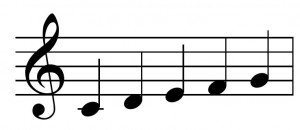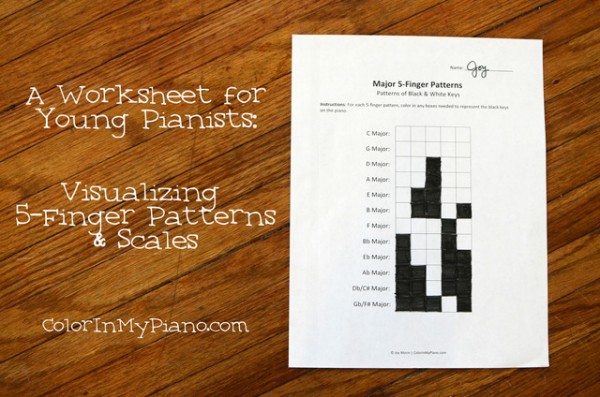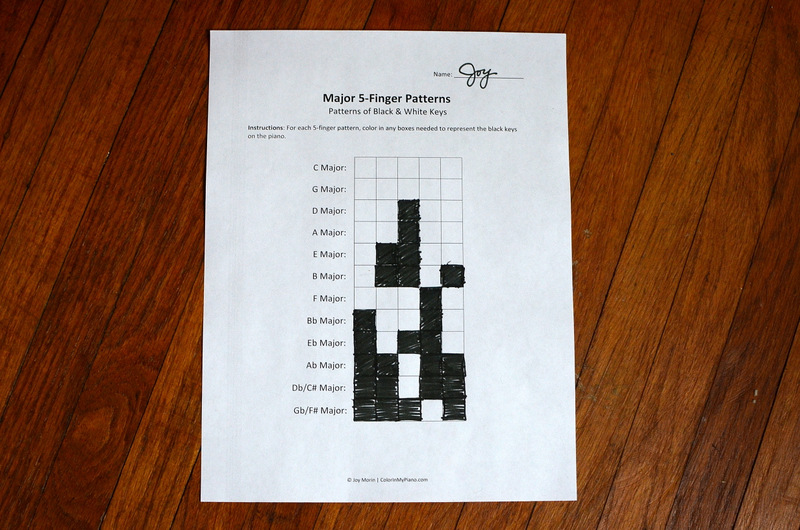 Every teacher approaches technique exercises a little bit differently. I usually start teaching students 5-finger patterns (aka pentascales) during the first month or two of study. I start by assigning the C Major 5-finger pattern (5FP) and sometimes G Major along with it. Every week or every-other-week, I add a new 5FP to their list, following the Circle of 5ths.
Every teacher approaches technique exercises a little bit differently. I usually start teaching students 5-finger patterns (aka pentascales) during the first month or two of study. I start by assigning the C Major 5-finger pattern (5FP) and sometimes G Major along with it. Every week or every-other-week, I add a new 5FP to their list, following the Circle of 5ths.
Personally, I don’t teach the theory behind the major 5FP’s until a little bit later (i.e., the pattern of whole and half steps: WWHW). To introduce each 5FP, I let the student figure out what black keys are needed — using their ear. I say: “Today we are going to add the D 5-finger pattern. There is a black key in this 5FP. Do you think you can figure out where the black key needs to be?” The student first plays the 5FP with all white keys, and we discuss that it doesn’t sound right — it doesn’t match the sound of the C and G 5FPs. The student then uses his/her ear and trial-and-error to discover that the 3rd note should be a black key. Now it matches! Leading the student through this kind of discovery makes the learning moment memorable.
The beauty of this approach also is that the student inherently learns the concept of transposition through this moment! The concept of being “in a key” and the concept of transposition between keys is such an integral part of the way music works, but is so often it is neglected until students begin playing scales and learning key signatures. However, after learning just two or three 5FPs, the teacher can easily ask the student to play a few familiar folk tunes by ear in different keys. (See my printable from a couple years back, “Melodies to Play by Ear and Harmonize.”) The student will understand that depending on what note the tune begins, they will need certain black keys in order for the tune to sound “right.”
Once the students knows the seven white key 5FPs, we stop for a few weeks to review those. I usually also change the order from the Circle of 5ths and ask them to start practicing them in order from C up the scale through B. Then, we add begin adding the five black key 5FPs. Once all the major 5FPs are learned, we spent a few more weeks reviewing those until they are everything is memorized securely.
I recently created a new set of worksheets to use with students throughout this process.

Each 5FP has a series of five boxes behind it, representing the five notes of the 5FP. The student’s job is the fill in the boxes that would be black keys on the piano. The goal is for the student to visually memorize the pattern of black and white keys for each 5FP, and this worksheet will help with that. I’ve made five pages in this pdf:
- Major 5FPs, in the order of the Circle of 5ths.
- Major 5FPs, in the order of the scale (C up through B).
- Minor 5FPs, in the order of the Circle of 5ths.
- Major Scales
- Natural Minor Scales
I hope you can make use of these worksheets! You can download this FREE pdf by visiting the Printables > Worksheets page, and scrolling to “5FPs & Scales – Patterns of Black & White Keys.” Enjoy!



Great post, this is exactly how I intro 5-finger patterns as well. The ear can teach little hands so much. Thanks for the neat printables!
I agree!
Do you use fingers 1-5 in RH even when starting on the black keys?
Yes, and I think this is typical. I’ve never heard of teachers use use fingering other than 1-5 for 5FPs.
Such a simple concept on the worksheet, but a perfect way to reinforce the patterns visually, thanks for sharing!
You’re welcome!
Wow! Such a great idea for early aural skills!
I am absolutely going to use this for all my beginners! Thank you so much! I think it’s a wonderful idea to have the black keys colored in on the sheet instead of perhaps writing in the note names (many of them may not know what sharps and flats are, yet!). Approximately how long would you say it takes the students to learn all of the white-note penta scales?
With young beginners (ages 5 and 6), sometimes we need to spend 2 weeks on each 5FP which means it takes up to 14 weeks to get through the white key 5FPs. Older students can learn then a lot more quickly — in fact, sometimes I pair up the easy ones (learn C & G together, learn D & A together, etc.). It shouldn’t take more than 6-9 months to get through all of the major 5FPs. I’m not really in a rush to get through the 5FPs, because I want the student to learn them securely — but I also don’t want to spend too much time on the first few 5FPs that the student starts equates the ones with more black keys as “hard.”
Clever idea! It looks like the screenshot from a Tetris game. (BTW looks like you got E-flat major wrong)
I’m with you in preferring to start over with one flat after getting up to 5 sharps so that the black keys are approached in ascending order of number of flats. Makes sense – this is what I do with my Cerebroom scale/arpeggio fingering sheet. But seeing your chart like this also gave me a silly thought (and after more thought, it actually didn’t seem so silly): the ending picture would form a seamlessly-transforming pattern if you just proceed around the circle of fifths without interruption (and of course without E-flat major being messed up, haha). Even from B major to G-flat major, you still technically only have 1 difference in the 5 finger pattern: the bottom note becomes a black key. Perhaps the benefit of seeing this pattern visually would be more beneficial to the student than the benefit of taking care of all white note keys before going onto the blacks? Or if you rearranged the order on the sheet, you could still of course ask students if they want skip down to F major before going back to G-flat just for their psychological comfort… but I doubt it would really matter that much.
Oops, how embarrassing that I messed up Eb! I was in a hurry yesterday to get my post up before my lessons started, and unfortunately that resulted in this mistake. I’ll fix my photo later when I get a chance.
There are lots of interesting patterns to be found, for sure! Another one is that some of the 5FP’s patterns have opposites: Db is the exact opposite pattern of D, Eb is the opposite of E, F is the opposite of F#, Ab is the opposite of A, and Bb is the opposite of B.
While I would enjoy pointing out patterns to the student such as this and the one you described, Chad, I think would probably still teach them in the order I do. I’m not sure if a 5- or 6-year-old beginner would follow the logic of the pattern you described — but I suppose an adult student might enjoy it. Regardless of the way the 5FPs are taught, of course, the end goal is for the student to be able to recall them quickly and easily. Pointing out interesting patterns is the icing on the cake!
Agreed that it’s icing on the cake, and don’t fret about your Eb major flaw – my degree in mathematics does not prevent me from making trivial arithmetic errors!
Thanks for posting and sharing, Joy! It was very timely for me and I used it along with some other materials for a group lesson on 5FPs yesterday.
Love the worksheet! It’s perfect for younger students. Thank you for sharing.
It’s this method (5FP) recommended for an adult beginner ?
Hi Joy! I love this set of worksheets because it’s completely different from note-reading for the pentascales. It goes along more with the patterns you see on the keys and the student with whom I tried it tonight was able to say “ok, shade in the second and third black keys” as she talked herself through it, seeing it as steps in a series of five without having to think of note names, almost like we do when we feel our way through the patterns. It also allows young students who are learning the pentascales to work with the patterns before they’ve even learned all of the absolute pitches on the staff. Thanks!